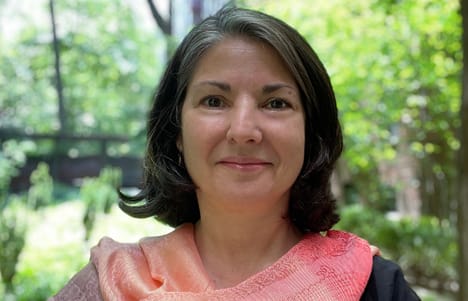
About the Meditation Podcast
Meditation session led by Kimberly Brown.
The guided meditation begins at 14:31.
For centuries Himalayan practitioners have used meditation to quiet the mind, open the heart, calm the nervous system, and increase focus. Now Western scientists, business leaders, and the secular world have embraced meditation as a vital tool for brain health.
Whether you’re a beginner, a dabbler, or a skilled meditator seeking the company of others, join expert teachers in a forty-five-minute weekly program designed to fit into your lunch break. Each session will be inspired by a different work of art from the Rubin Museum’s collection and will include an opening talk, a twenty-minute meditation session, and a closing discussion.
This program is supported in part by the Hemera Foundation with thanks to our presenting partners Sharon Salzberg, the Interdependence Project, and Parabola Magazine.
Related Artwork

Theme: Interconnectedness
The unusually large dimensions of this painting suggest that it was intended as a mural; the painted cloth would be glued to a temple wall. This technique is most common from the 19 century onward. That the deities are set in a common landscape is almost imperceptible due to the almost baroque density of the composition, with deities, halos, and lotuses cut off at the edges of the canvas. The rich jewelry with thick pearls, the flower-studded background, the almost abstract rendering of the rocks, and the variety of halo forms used in this painting are also typical of the nineteenth century.
The forest goddess Parnashavari is easily recognized by her distinctive garland and skirt made of thatched green leaves. She is associated with the Shavari tribe of ancient India and is an example of an Indian folk deity who has been absorbed into Tantric Buddhism. She is associated with the practice of healing, particularly curing contagious diseases and suppressing epidemics. Her central face is semi-wrathful with a furrowed brow and bearing tiny fangs. In one of her hands she holds a fan of new leaves, heavy with fruit and flowers. She is here associated with Buddha Akshobhya, represented at the top center, and another wrathful goddess with six arms underneath her.
About the Speaker

Kimberly Brown is a meditation teacher and author. She leads classes and retreats that emphasize the power of compassion and kindness meditation to reconnect us to ourselves and others. Her teachings provide an approachable pathway to personal and collective well-being through effective and modern techniques based on traditional practices. She studies in both the Tibetan and Insight schools of Buddhism and is a certified mindfulness instructor. Her new book, Navigating Grief And Loss: 25 Buddhist Practices to Keep Your Heart Open to Yourself and Others, was published in November 2022, and an updated edition of Steady, Calm, and Brave will be released in January 2023. Both are published by Prometheus Books. You can learn more about Kimberly on her website.
